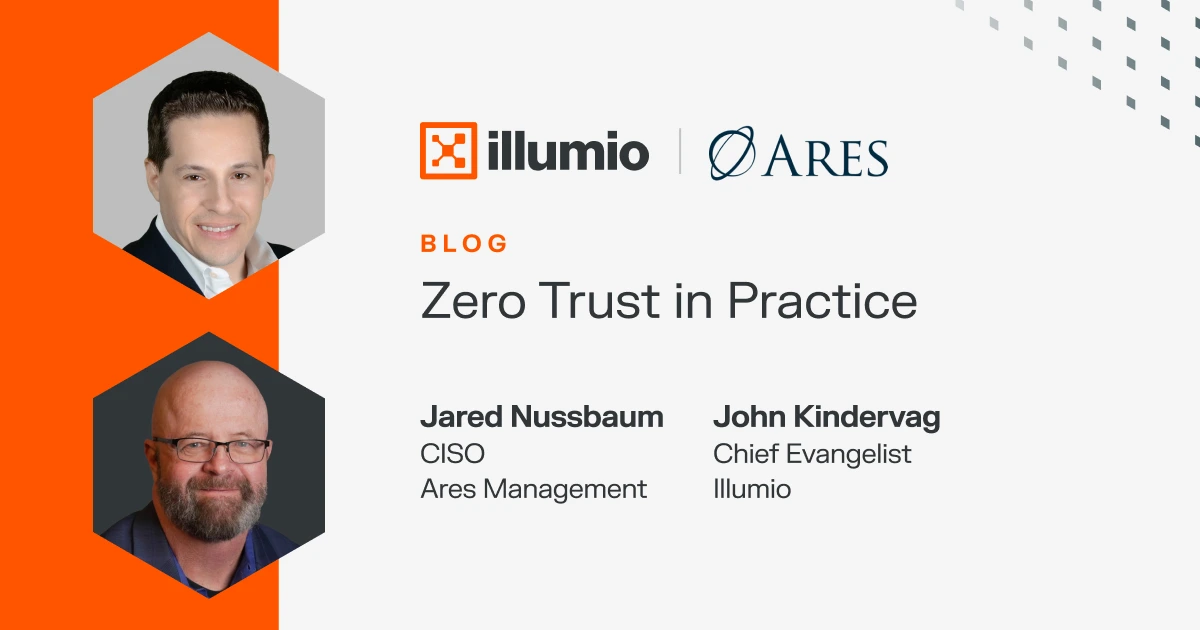Was Sie von den Strategien der U.S. Army und der Navy SEAL über Zero Trust lernen können
Zwei Führungspersönlichkeiten. Zwei sehr unterschiedliche Wege zum Service.
Clint Bruce war ein herausragender Footballspieler an der U.S. Naval Academy mit einer Chance auf die NFL - bis er wegging, um ein Navy SEAL zu werden, der Stadionlichter gegen Spezialoperationen eintauschte.
General Viet Xuan Luong floh als Flüchtlingskind aus Saigon und wurde später der erste in Vietnam geborene General in der Geschichte der US-Armee.
Was haben sie beide gemeinsam? Eine Denkweise, die in Umgebungen mit hohem Einsatz geprägt wurde, in denen Vertrauen, Klarheit und Vorbereitung alles sind. Dies prägte die gesamte Diskussion in unserem kürzlich stattgefundenen LinkedIn Live-Meeting zum Thema „Zero Trust, Terrain und die Frage der Überlegenheit“.
In der Sitzung diskutierten Bruce und General Luong gemeinsam mit dem Zero-Trust-Erfinder und Chief Evangelist von Illumio, John Kindervag , wie militärische Prinzipien wie Gelände, Vertrauen und Disziplin einen Fahrplan für stärkere Cybersicherheitsstrategien bieten. Es war eine Diskussion über Führung, Denkweise und Mission, die eine Brücke zwischen dem Schlachtfeld und der Vorstandsetage schlägt.
Warum Terrain und Vertrauen alles sind
Für Bruce ist das Gelände sowohl Geografie als auch die Grundlage jeder strategischen Entscheidung.
"Ohne ein Geländemodell führt man keine Operationen durch", erklärte er. "Cyber ist Terrain, und der Verteidiger muss es besser verstehen als der Angreifer."
Sowohl auf dem Schlachtfeld als auch im Rechenzentrum ist die Lektion die gleiche. Du kannst nicht schützen, was du nicht verstehst. Wenn Sie Ihre Umgebung – Ihr Gelände – kennen, behalten Sie die Oberhand. Ohne sie kämpfst du blind.
Ohne ein Geländemodell führen Sie keine Vorgänge durch. Cyber ist Terrain, und der Verteidiger muss es besser verstehen als der Gegner.
Bruce, der jetzt die HoldFast Foundation leitet und Führungskräfte aus verschiedenen Branchen betreut, erzählte, wie man Vertrauen verdient und nie vorausgesetzt.
"In meiner Welt ist Vertrauen nicht gegeben. Es ist gebaut", sagte Bruce. "Man verdient es sich durch Klarheit, Konsequenz und Mut."
General Luong schloss sich diesem Ansatz aus der Perspektive der Führung an. In seiner militärischen Laufbahn war Klarheit für den Erfolg der Mission unerlässlich.
"Als Kommandant konnte ich nicht davon ausgehen, dass jeder im Team über perfekte Informationen verfügte", sagte er. "Ich musste durch Wiederholung, Struktur und Kommunikation Klarheit schaffen und Vertrauen aufbauen."
So wie Elite-Teams in einer High-Stakes-Mission alles validieren und verifizieren, geht Zero Trust ohne eine klare, kontinuierliche Validierung nichts über Benutzer, Geräte oder Anwendungen aus.
Denn sowohl im Krieg als auch in der Cybersicherheit können die Kosten für die Annahme von Vertrauen katastrophal sein.
Die Terrain-Lücke in der Cybersicherheit und wie Zero Trust sie behebt
Kindervag erklärte, dass der traditionellen Cybersicherheit eines der wesentlichsten Konzepte der Militärstrategie fehlt: ein klares Geländemodell.
"Wenn ich die meisten Unternehmen bitten würde, ihr Netzwerkgelände zu zeichnen, könnten sie das nicht", sagte er. "Man würde nicht blind in den Kampf ziehen, aber so arbeiten die meisten von uns in der Cybersicherheit."
Um den Punkt zu verdeutlichen, zeigte Kindervag ein Bild von Präsident Obamas Amtseinführung, auf dem er von Agenten des Secret Service in einem mehrschichtigen, visuellen Umkreis flankiert wurde.

Die Agenten wussten drei Dinge:
- Wer der Präsident war
- Wo er war
- Wie man ihn segmentiert und vor potenziellen Bedrohungen schützt
"Das ist Zero Trust in der realen Welt", sagte Kindervag. "Es geht nicht darum, höhere Mauern zu bauen. Es geht darum, zu verstehen, wen und was man schützt, wo es lebt und wie es mit allem um sich herum interagiert."
Sichtbarkeit ist die neue Hochburg
Eine der stärksten Metaphern der damaligen Zeit kam von Bruce.
"Bei Spezialoperationen ist das erste, was man tut, die Anhöhe zu sichern", sagte er. "Wenn du es nicht tust, wird es dein Gegner tun."
Diese "Überlegenheit" in der Cybersicherheit ist die Transparenz. Ohne sie müssen Sicherheitsteams auf Bedrohungen reagieren, anstatt sie proaktiv einzudämmen.
"Man kann nicht verteidigen, was man nicht sehen kann", bekräftigte Kindervag. "Zero Trust beginnt mit Transparenz – dem Verständnis Ihres Terrains."
Luong stimmte zu. "Die besten Kommandeure, die ich kannte, waren nicht diejenigen mit den lautesten Stimmen", sagte er. "Sie waren diejenigen, die ihr Terrain kannten und im Nebel des Krieges Entscheidungen treffen konnten."
Er fügte hinzu, dass das Gleiche für die Führung im Bereich Cybersicherheit gelte: "Sichtbarkeit und Verständnis sind Kraftmultiplikatoren. Man gewinnt, wenn man schnelle, klare Entscheidungen treffen kann, die auf der Realität und nicht auf Vermutungen basieren."
Von physischen Schlachtfeldern bis hin zu digitalen Schlachtfeldern ist die Mission die gleiche
Während der gesamten Sitzung war der rote Faden, der alles zusammenhielt, die Führung. Nicht nur den Titel oder den Rang, sondern auch die Einstellung.
"Du bist der Situation nicht gewachsen", sagte Bruce. "Du stellst dich auf dein Vorbereitungsniveau ein."
Zero Trust bietet diese Vorbereitung. Es gibt Unternehmen die Möglichkeit, klar zu sehen, entschlossen zu reagieren und zu kontrollieren, was in ihrer Umgebung passiert, selbst nachdem ein Angreifer eingedrungen ist.
Du bist der Situation nicht gewachsen. Du stellst dich standardmäßig auf dein Vorbereitungsniveau ein.
Darauf konzentriert sich Illumio jeden Tag. In der Post-Breach Ära reicht es nicht mehr aus, zu versuchen, Bedrohungen fernzuhalten. Du musst bereit sein, sie in dem Moment einzudämmen, in dem sie durchbrechen.
Sind Sie bereit, Ihre Höhenlage zu überdenken?
Wenn Sie im Bereich Cybersicherheit führend sind, besteht Ihre Aufgabe nicht nur darin, Tools zu kaufen und Angriffe zu blockieren. Es geht darum, Ihr Terrain zu verstehen, Klarheit in Ihrer Umgebung zu schaffen und ein Framework einzuführen, das von Sicherheitsverletzungen ausgeht und Kontrolle ermöglicht.
Und wie Kindervag betonte, ist Zero Trust kein Produkt. Es ist ein Mentalitätswandel.
Genau wie im Kampf beginnt dieser Wandel damit, die Mission zu verstehen und die Stellung zu halten, egal was auf dich zukommt.
Sehen Sie sich die vollständiges LinkedIn Live um zu erfahren, wie Transparenz, Klarheit und Zero-Trust-Mentalität Ihre Cyberstrategie neu gestalten können.
.png)

.webp)



.webp)